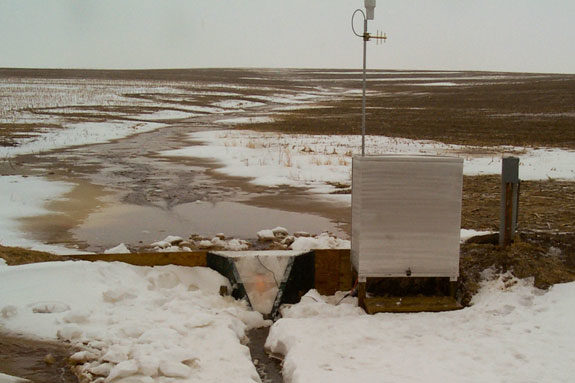In the nine years the Discovery Farms program has been operating, Dennis Frame has been able to identify high-risk situations leading to pollution from runoff.
“Discovery Farms are real-life Wisconsin farms that all face different environmental challenges,” said Frame, co-director of this University of Wisconsin project. “Our goal is to work with producers to better understand and reduce sources of phosphorus and nitrogen.”
Frame says that data has been collected from six core farms and three special projects. Monitoring stations are set up in natural waterways and manmade tiles, and data has been retrieved every 15 minutes, 365 days a year. A meteorology station is also set up to measure wind speed and direction, air temperature, solar radiation, relative humidity and soil moisture.

The physical settings vary to mimic the Wisconsin’s mixed geography. They differ from a field with a 33 percent slope in Buffalo County to very flat fields in Kewaunee County.
“Just because a farm looks tough or is in a tough setting does not mean bad numbers,” he said.
“My goal is to identify critical conditions, time periods and farming systems,” Frame says. “All farming systems have losses. The highest phosphorus losses we found were on a grazing farm. I’m not criticizing that farm. Once we understood it, we were able to correct it.
“In fact, all land, whether it’s lawn, woods, pasture, corn or alfalfa, contributes some level of non-point- source pollution.
“As an industry we need to convey that if you have trees, grass or flowers, you have phosphorus loss. We’ve measured farms that have less pollution from farmland than from their woodlands and grasslands because the crop is removed from farmland,” Frame says.
The key is not to eliminate losses but to get them to acceptable levels through adjusting management practices. He notes, “Water quality will only improve if practices are adapted and adopted on farms throughout the state.”
With the data collected to date, Frame is already able to identify certain high-risk situations.
“On most farms it’s one, two or three fields. It’s not every field. But every field can have risk at a certain point in time,” he says. “In reality, the best fields on farms have losses at some times of year and the worst fields have no losses some times of the year.”

The farms in the program averaged a loss of 2 pounds of phosphorus per acre, below the 6 pound accepted loss. Nitrogen losses – not including tile – were averaging 7 pounds and that’s taking into consideration that 10 pounds of nitrogen is contributed from rainfall every year.
“On average we are doing significantly better than everybody thought,” Frame says.
In general, sediment losses from fields are phenomenally low. The average sediment loss across all farm years on Discovery Farms was 670 pounds per acre. The accepted amount in Wisconsin is 10,000 pounds. Some farms averaged less than 100 pounds sediment per acre, Frame reports. Nearly all sediment loss occurred during non-frozen ground periods.
Frame tells dairymen, “You guys are doing a good job, and you better start telling people you are doing a good job.”
The timing of the application of manure and/or fertilizer plays a critical role in determining nutrient losses. There are two critical periods when runoff is high – during snowmelt and when non-frozen soils are close to saturation.

According to the data set that Frame and his team have collected, the highest risk period is just before the snow leaves in February and March. About 55 percent of annual runoff occurred during that time period. Nutrient losses were much less (10 percent or less) when manure was applied in the fall or early winter. “It appears that late winter poses a greater risk than early winter. This is because the volume of runoff is higher and the potential for rain on snow, or rapid snowmelt, is higher.”
Frame says he is not in favor of a state law that says manure cannot be spread during the winter months. “Having all livestock farms apply manure in a narrow window greatly increases risk,” he added, noting a two-week window for it not to rain could be unattainable. “Requiring storage also does not guarantee that you’re not going to have a runoff event.”
The second-highest period of risk is in May and June when the soils are near saturation and rain is likely. At this time the minimum amount of rain to generate runoff is between 3/4 and 8/10 of an inch.
Managing nutrients during these critical runoff periods can dramatically reduce nutrient losses, Frame says.
Even though the Discovery Farms program has come to some conclusions, a lot of data still remains to be analyzed and more research is needed. Frame and his team will continue to look into early winter, measuring distance and the rate of runoff, and forecasting for appropriate times to spread manure. PD




